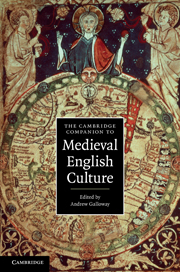Book contents
- Frontmatter
- Introduction
- Part one Theaters of culture: political, legal, material
- Part two Cultural ideals and cultural conflicts
- 4 Social ideals and social disruption
- 5 “Celtic” Visions Of England
- 6 The idea of sanctity and the uncanonized life of Margery Kempe
- Part Three Literacies, languages, and literatures
- Part four Legacies and re-creations
- Guides to further reading
- Index
4 - Social ideals and social disruption
from Part two - Cultural ideals and cultural conflicts
Published online by Cambridge University Press: 28 July 2011
- Frontmatter
- Introduction
- Part one Theaters of culture: political, legal, material
- Part two Cultural ideals and cultural conflicts
- 4 Social ideals and social disruption
- 5 “Celtic” Visions Of England
- 6 The idea of sanctity and the uncanonized life of Margery Kempe
- Part Three Literacies, languages, and literatures
- Part four Legacies and re-creations
- Guides to further reading
- Index
Summary
Social cohesion
Communitas
Any traveler through the modern English countryside quickly gains an impression of the intense localism of communities formed long ago and of a long-lingering memory of lordly control over them. Techniques of agriculture that sustained these villages often required both a base-level ideal and a daily practice of communal cooperation. Yet these were scarcely (to borrow the words of a popular Monty Python film) anarcho-syndicalist communes; lordship exercised over villagers was another fact of life, accepted if perhaps not considered by all and in every aspect an ideal. Its reality remains embedded in a variety of colorful place names. Often some dominant family has stamped its name forever upon the land, or the lordship recorded is that of an abbey or episcopal see. Such evidence is a useful reminder of the distinctly local horizons to so much of medieval life in England as elsewhere in Europe.
Yet important as it is to remember the local or regional dimension throughout medieval Europe, it is likewise important to realize that the imprint of lordship was only the first of several matrices informing and enforcing a basic sense of community – a concept that need not be considered warm and cuddly. Two additional frameworks stretched their regulation over the landscape. These provide sound reasons for thinking that in the case of England an ideal of community operated not only at the level of villages but even at the level of the kingdom.
- Type
- Chapter
- Information
- The Cambridge Companion to Medieval English Culture , pp. 85 - 106Publisher: Cambridge University PressPrint publication year: 2011

